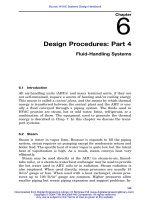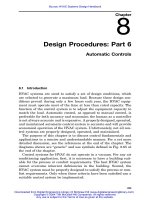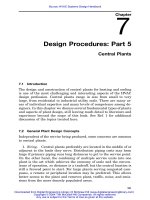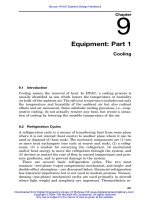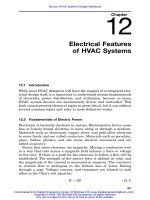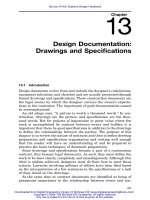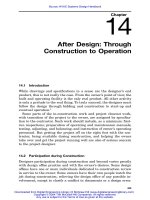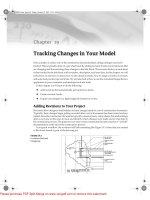Tài liệu HVAC Systems Design Handbook part 19 doc
Bạn đang xem bản rút gọn của tài liệu. Xem và tải ngay bản đầy đủ của tài liệu tại đây (438.41 KB, 16 trang )
469
Chapter
19
Engineering Fundamentals:
Part 4
Psychrometrics
19.1 Introduction
Psychrometrics deals with the thermodynamic properties of moist air,
which is the final heat transport medium in most air conditioning
processes. The use of psychrometric tables and charts allows the de-
signer to make a rational and graphic analysis of the desired air con-
ditioning processes.
The general use of psychrometric data and charts began with the
publications of Dr. Willis Carrier in the 1920s. In the 1940s, a research
project conducted at the University of Pennsylvania by Goff and
Gratch [sponsored by American Society of Heating and Ventilating
Engineers (ASHVE)] resulted in new, more accurate data, which re-
mained definitive until the results of further research were published
in the 1980s.
This chapter deals with the subject rather briefly and simply, but
in sufficient depth to provide an adequate background for HVAC de-
sign. For further study see Ref. 1.
19.2 Thermodynamic Properties
of Moist Air
Moist air is a mixture of atmospheric air and water vapor. Dry air
contains no water vapor. Saturated air contains all the water it can
hold at a specified temperature and pressure. The properties of moist
Source: HVAC Systems Design Handbook
Downloaded from Digital Engineering Library @ McGraw-Hill (www.digitalengineeringlibrary.com)
Copyright © 2004 The McGraw-Hill Companies. All rights reserved.
Any use is subject to the Terms of Use as given at the website.
470 Chapter Nineteen
air can be evaluated by the perfect gas laws with only a small degree
of error, which is not significant in most HVAC processes. The prop-
erties of interest in this discussion are the dry-bulb (db), wet-bulb
(wb), and dew point temperatures; humidity ratio; degree of satura-
tion; relative humidity (RH); and enthalpy and density.
19.2.1 Temperatures
The dry-bulb temperature T
db
is the temperature of the moist air as
read on an ‘‘ordinary’’ thermometer. When not otherwise defined, tem-
perature means the dry-bulb temperature. In this text, the Fahrenheit
scale is used.
The wet-bulb temperature T
wb
is measured by a thermometer on
which the bulb is covered with a wetted cloth wick. Air is blown across
the wick, or the thermometer is moved rapidly through the air (as in
the sling psychrometer), resulting in a cooling effect due to water evap-
oration. The amount of water which can be evaporated (and, therefore,
the cooling effect) is limited by the humidity already present in the
air. The temperature obtained in this manner is not the same as the
thermodynamic wet-bulb temperature used in calculating psychro-
metric tables, but the error is small. The difference between the dry-
and wet-bulb temperatures is sometimes called the wet-bulb depres-
sion.
The dew point temperature T
dp
of moist air is defined by cooling the
air until it is saturated and moisture begins to condense out of the
mixture. For saturated air, these three temperatures are equal, as
shown by their intersection on the saturation curve of the psychro-
metric chart.
19.2.2 Humidity ratio
The humidity ratio w is the ratio of the mass of the water vapor to
the mass of the dry air in a sample of moist air. The specific humidity
is the ratio of the mass of the water vapor to the total mass of the
moist air sample. Although the two terms are often used interchange-
ably, they are not identical.
19.2.3 Degree of saturation
The degree or percentage of saturation
is the humidity ratio w of a
moist air sample divided by the humidity ratio w
s
of saturated air at
the same temperature and pressure.
w
ϭ (19.1)
w
s
Engineering Fundamentals: Part 4
Downloaded from Digital Engineering Library @ McGraw-Hill (www.digitalengineeringlibrary.com)
Copyright © 2004 The McGraw-Hill Companies. All rights reserved.
Any use is subject to the Terms of Use as given at the website.
Engineering Fundamentals: Part 4 471
19.2.4 Relative humidity
The relative humidity
is the ratio of the mole fraction of water vapor
X
w
in a moist air sample to the mole fraction of saturated air X
ws
at
the same temperature and pressure. The relative humidity is ex-
pressed as a percentage, from 0 percent (dry air) to 100 percent (sat-
urated air). It can also be defined in terms of the partial pressures of
the water vapor in the samples:
P
w
ϭ (19.2)
P
w
s
Relative humidity values differ from percentage of humidity except at
0 and 100 percent.
19.2.5 Enthalpy
The enthalpy h is the total heat of a sample of material, in Btu per
pound, including internal energy. However, in the ASHRAE tables and
charts, the value of the enthalpy of dry air is arbitrarily set to zero at
0ЊF. This is satisfactory in terms of enthalpy differences, but enthalpy
ratios may not be used. The enthalpy of a moist air sample is
h ϭ h ϩ wh (19.3)
ag
where h
a
ϭ enthalpy of dry air in sample
w ϭ humidity ratio of sample
h
g
ϭ enthalpy of water vapor in sample (as a gas)
h ϭ total enthalpy of sample (all at temperature of sample)
19.2.6 Volume and density
The volume of a moist air sample is expressed in terms of unit mass,
in cubic feet per pound in this text. The density is the reciprocal of
volume, in pounds per cubic foot.
19.3 Tables of Properties
The above-described properties and others are tabulated in Table 19.1,
which is abstracted from an ASHRAE table. Table 19.1 is calculated
for moist air at the standard atmospheric pressure of 14.696 lb/in
2
(29.921 inHg). At any other atmospheric pressure, these data will be
different, because the partial pressure of water vapor is a function of
temperature only, independent of pressure (see Sec. 19.7).
It is possible to calculate new values for a table similar to Table 19.1
at a different atmospheric pressure, by starting from the standard
Engineering Fundamentals: Part 4
Downloaded from Digital Engineering Library @ McGraw-Hill (www.digitalengineeringlibrary.com)
Copyright © 2004 The McGraw-Hill Companies. All rights reserved.
Any use is subject to the Terms of Use as given at the website.
472
TABLE
19.1 Thermodynamic Properties of Moist Air
Engineering Fundamentals: Part 4
Downloaded from Digital Engineering Library @ McGraw-Hill (www.digitalengineeringlibrary.com)
Copyright © 2004 The McGraw-Hill Companies. All rights reserved.
Any use is subject to the Terms of Use as given at the website.
473
Engineering Fundamentals: Part 4
Downloaded from Digital Engineering Library @ McGraw-Hill (www.digitalengineeringlibrary.com)
Copyright © 2004 The McGraw-Hill Companies. All rights reserved.
Any use is subject to the Terms of Use as given at the website.
474
TABLE
19.1 (Continued )
*Extrapolated to represent metastable equilibrium with undercooled liquid.
SOURCE
: Copyright 1997, American Society of Heating, Refrigerating and Air Conditioning Engineers,
Inc., www.ashrae.org. Abstracted by permission from ASHRAE Handbook, 1997 Fundamentals, Chap.
6, Table 2.
Engineering Fundamentals: Part 4
Downloaded from Digital Engineering Library @ McGraw-Hill (www.digitalengineeringlibrary.com)
Copyright © 2004 The McGraw-Hill Companies. All rights reserved.
Any use is subject to the Terms of Use as given at the website.
